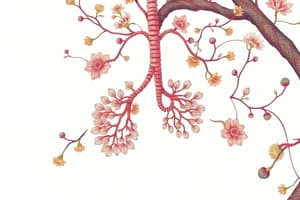Podcast
Questions and Answers
Match the following metabolic pathways with their primary function:
Match the following metabolic pathways with their primary function:
Glycolysis = Breakdown of glucose into pyruvate Citric Acid Cycle = Oxidation of acetyl-CoA to generate ATP, NADH, FADH2, and CO2 Oxidative Phosphorylation = Synthesis of ATP using energy from NADH and FADH2 Protein Synthesis = Assembly of amino acids into polypeptide chains
Match the following metabolic pathways with their location within the cell:
Match the following metabolic pathways with their location within the cell:
Glycolysis = Cytoplasm Citric Acid Cycle = Mitochondrial matrix Oxidative Phosphorylation = Inner mitochondrial membrane Protein Synthesis = Ribosomes
Match the following terms with their related metabolic concepts:
Match the following terms with their related metabolic concepts:
Catabolic Pathways = Breakdown of complex molecules Anabolic Pathways = Synthesis of complex molecules ATP = Energy currency of cells Enzymes = Biological catalysts
Match the following metabolic processes with their energy considerations:
Match the following metabolic processes with their energy considerations:
Match the following regulatory mechanisms with their descriptions:
Match the following regulatory mechanisms with their descriptions:
Match the following examples with their respective types of metabolic pathways:
Match the following examples with their respective types of metabolic pathways:
Match the following metabolic processes with their primary role:
Match the following metabolic processes with their primary role:
Match the following metabolic principles with their descriptions:
Match the following metabolic principles with their descriptions:
Match the following metabolic intermediates with their primary roles:
Match the following metabolic intermediates with their primary roles:
Match the following metabolic pathway components with their primary functions:
Match the following metabolic pathway components with their primary functions:
Match the following metabolic concepts with their descriptions:
Match the following metabolic concepts with their descriptions:
Match the following examples with their related metabolic principles:
Match the following examples with their related metabolic principles:
Flashcards
Metabolic Pathways
Metabolic Pathways
Series of connected chemical reactions in a cell catalyzed by enzymes.
Catabolic Pathways
Catabolic Pathways
Pathways that break down complex molecules into simpler ones, releasing energy.
Anabolic Pathways
Anabolic Pathways
Pathways that synthesize complex molecules from simpler ones, requiring energy.
ATP (Adenosine Triphosphate)
ATP (Adenosine Triphosphate)
Signup and view all the flashcards
Glycolysis
Glycolysis
Signup and view all the flashcards
Citric Acid Cycle (Krebs Cycle)
Citric Acid Cycle (Krebs Cycle)
Signup and view all the flashcards
Oxidative Phosphorylation
Oxidative Phosphorylation
Signup and view all the flashcards
Feedback Inhibition
Feedback Inhibition
Signup and view all the flashcards
Compartmentalization
Compartmentalization
Signup and view all the flashcards
Citric Acid Cycle
Citric Acid Cycle
Signup and view all the flashcards
Acetyl-CoA
Acetyl-CoA
Signup and view all the flashcards
NADH and FADH2
NADH and FADH2
Signup and view all the flashcards
Cellular Respiration
Cellular Respiration
Signup and view all the flashcards
Study Notes
Overview of Metabolic Pathways
- Metabolic pathways are a series of interconnected chemical reactions that occur within a cell.
- These reactions are catalyzed by enzymes, which are biological catalysts that speed up the rate of chemical reactions without being consumed in the process.
- Pathways can be categorized as catabolic (breakdown of complex molecules into simpler ones) or anabolic (synthesis of complex molecules from simpler ones).
- The pathways are highly regulated to maintain homeostasis and ensure the optimal use of resources.
Catabolic Pathways
-
Catabolic pathways break down complex molecules into simpler ones, releasing energy in the process.
-
This energy is often stored as ATP (adenosine triphosphate), a crucial energy currency in cells.
-
Examples of catabolic pathways include glycolysis, the citric acid cycle, and oxidative phosphorylation.
-
These pathways play a crucial role in providing energy for cellular activities.
-
Glycolysis: A ten-step process that breaks down glucose into pyruvate, producing ATP and NADH. This occurs in the cytoplasm.
-
Citric Acid Cycle (Krebs Cycle): A cyclical pathway that further oxidizes acetyl-CoA derived from pyruvate, generating ATP, NADH, FADH2, and CO2. This occurs in the mitochondrial matrix.
-
Oxidative Phosphorylation: A process where NADH and FADH2 generated from glycolysis and the citric acid cycle are oxidized, and the energy from this process is used to synthesize ATP. This occurs in the inner mitochondrial membrane.
Anabolic Pathways
- Anabolic pathways synthesize complex molecules from simpler ones, requiring energy input.
- The energy needed for the synthesis comes primarily from ATP generated in catabolic pathways.
- Examples of anabolic pathways include protein synthesis, lipid synthesis, and glycogen synthesis.
- These pathways are crucial for cell growth, repair, and maintenance.
Key Concepts in Metabolic Pathways
- Energy Considerations: Pathways are tightly coupled to energy transfer/storage. Energy is either released or required. This often involves redox reactions.
- Regulation: Pathways are regulated to ensure the proper balance of intermediates and provide the necessary molecules in response to cellular needs.
- Intermediates: Metabolic pathways often share intermediates. This allows for flexibility and integration within the biochemical network.
- Feedback Inhibition & Activation: Key regulatory mechanisms involving signals and response to levels of end products.
- Compartmentalization: Metabolic pathways are often localized to specific cellular compartments (e.g., cytoplasm, mitochondria).
Common Metabolic Intermediates and their Roles
- Glucose: A primary energy source, broken down through glycolysis and subsequently further processed in the citric acid cycle & oxidative phosphorylation.
- Pyruvate: An important intermediate in glucose metabolism, leading to either further catabolism or anabolism through different pathways.
- Acetyl-CoA: Plays a central role in connecting many metabolic pathways by allowing entry into the citric acid cycle for further oxidation.
- ATP (Adenosine Triphosphate): The primary energy currency of the cell.
- NADH and FADH2: Electron carriers that transfer high-energy electrons to the electron transport chain for ATP generation.
Importance of Metabolic Pathways
- Crucial for maintaining life processes
- Essential for providing energy and building blocks for cellular activities.
- The regulation ensures that the pathways operate in a carefully controlled manner.
- Disturbances in metabolic pathways can lead to various diseases and health issues.
Connections between Pathways
- Catabolic and anabolic pathways are interconnected, sharing some intermediates and enzymes but often operating with opposite directions and regulation mechanisms. This allows for flexibility, homeostasis and responses to fluctuating demands.
Example: Role of Metabolic Pathways in Exercise
- During exercise, the body increases its demand for ATP.
- Catabolic pathways like glycolysis and the citric acid cycle are activated to generate more ATP, using glucose or fats as energy sources.
- Anabolic pathways may also be involved, for example in protein synthesis for muscle repair.
- The balance and regulation of these pathways are critical for optimal performance and recovery.
Other Important Metabolic Concepts
- Cellular Respiration: The overall process of oxidizing organic molecules to generate ATP.
- Photosynthesis: The process in plants and some bacteria to convert light energy into chemical energy, forming glucose from CO2 and water.
Studying That Suits You
Use AI to generate personalized quizzes and flashcards to suit your learning preferences.




